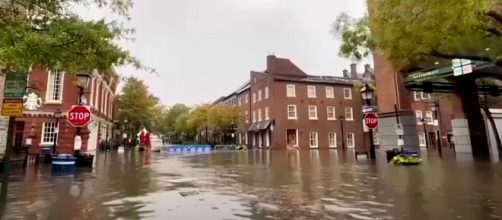One of the offshoots of Climate change is sea-level rise. The National Oceanic and Atmospheric Administration (NOAA) predict that such a situation could present major problems in the United States.
The future scenario could witness the rise in sea level by another 10 to 12 inches on average by 2050. It could have an adverse effect on cities close to the sea, and there would be many of them. The people chose such locations for ease of doing business using maritime facilities in the past. The rising seas could rob them of their dreams.
NOAA's report cautions that the forecasts are about the increase in the frequency of coastal flooding.
That could happen even though there might not be climatic disturbances like storms or heavy rainfall. Gina McCarthy is the U.S. climate adviser. She cautions that the new data "is blinking code red."
Sea-level predictions usually focus on the year 2100. However, scientists hope the 2050 data will help people realize the seriousness and go in for advance planning. That would give them time to prepare and adapt to climate change. A professor at University College London says: "The changes are slow and incremental, but after decades would become devastating without proper action."
Climate change is driving sea-level rise
Melting glaciers and ice sheets expand the volume of water as it warms. As a result, rising sea level is a global phenomenon, and it is due to climate change.
In order to reverse this trend, the world should eliminate fossil fuels that generate harmful greenhouse gases and embrace renewable energy. In the U.K., the average rise by 2100 would be around 20 inches.
The increase would vary from place to place and lead to coastal flooding. Scientists have cautioned that some of these changes might be irreversible. The effects would remain for ages. By 2050, moderate flooding could occur several times more than it does today, says Nicole LeBoeuf, NOAA national ocean service director.
The U.S. coast would have to deal with a sea-level rise of 10-12 inches by 2050
According to the report, the U.S. coastal regions would witness increasing bouts of flooding, and those will not be only from high tides.
The rise would not follow any set pattern, but would be higher along the Atlantic and Gulf shores.
The reason could be greater land subsidence in those places when compared to the Pacific coasts. "I can tell you with complete confidence that these are not the kind of changes that we grew up with," says Nicole LeBoeuf.
Less greenhouse gas emissions can reduce sea-level rise
The suggestion of NOAA is to take tough action to lower greenhouse gas emissions. That could help to reduce the extent of the damage. The NOAA prepared the report in collaboration with several federal agencies. It based its findings on several authentic sources.
These include a combination of tide gauge measurements, satellite observations, and analysis from the latest report of the Intergovernmental Panel on Climate Change IPCC.
Officials add that the report is in tune with earlier conclusions of the IPCC and other entities on the subject. Experts believe the cause is the melting of ice sheets and glaciers on account of the increase in global temperatures.


